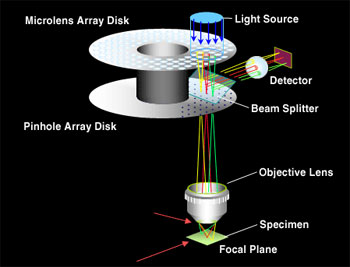Two disadvantages of the Nipkow disk are the extremely low light throughput and the fixed pinhole size.


One method of increasing the light throughput is to add a second disk containing microlenses to capture and focus more light onto the pinholes. Yokagawa uses this mechanism to increase the amount of light. Notice that the primary dichroic mirror is a "Reverse" dichroic. It passes short excitation light and reflects long wavelength emitted light.

To address the second shortcoming, Some manufacturers offer a "Sweep Scanner" that uses a solid state microlens array. Light from a laser is divided into many individual beams that are raster-scanned across a sample. Fluorescent light is descanned through a second array of pinholes. This second array has several parallel banks of pinholes with different diameters. Thus, in this system, the light can be descanned using various (fixed) pinhole diameters that match the Airy disc diameter of the available objective lenses.
The system can acquire confocal images at 250 images/sec.
Pinhole diameter
Light throughput